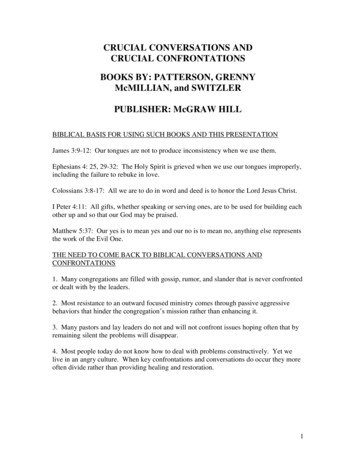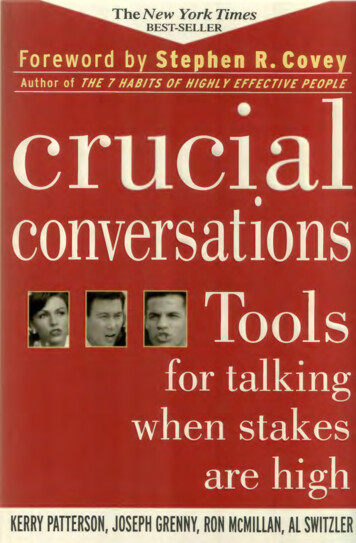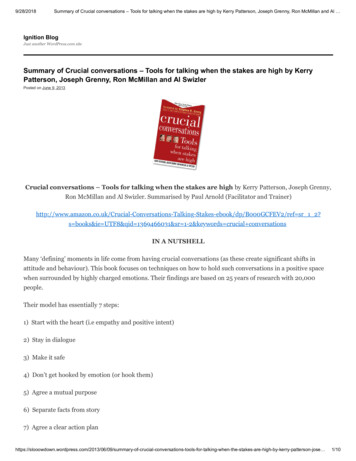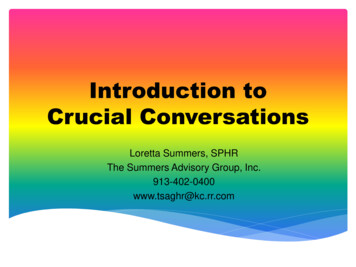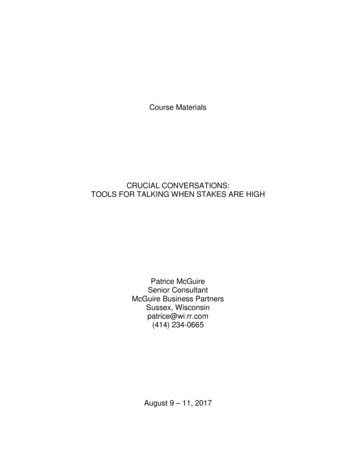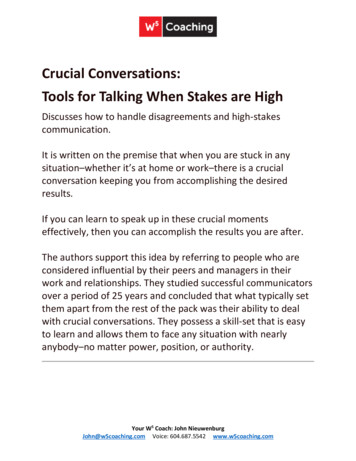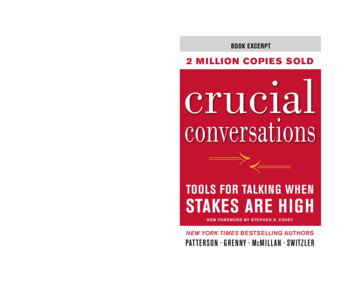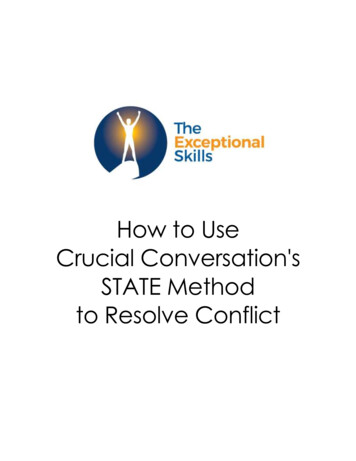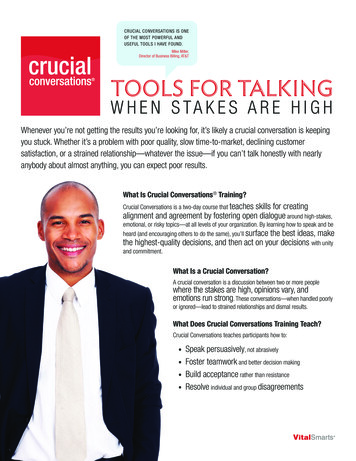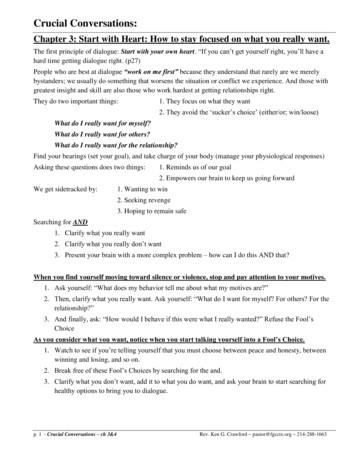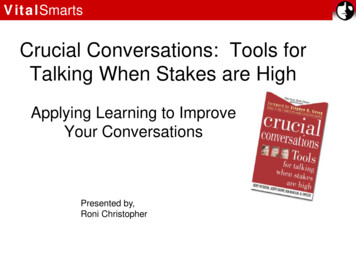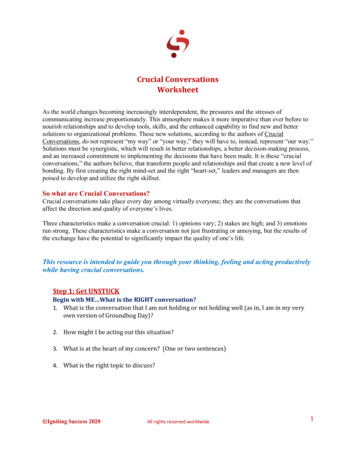
Transcription
Crucial ConversationsWorksheetAs the world changes becoming increasingly interdependent, the pressures and the stresses ofcommunicating increase proportionately. This atmosphere makes it more imperative than ever before tonourish relationships and to develop tools, skills, and the enhanced capability to find new and bettersolutions to organizational problems. These new solutions, according to the authors of CrucialConversations, do not represent “my way” or “your way,” they will have to, instead, represent “our way.”Solutions must be synergistic, which will result in better relationships, a better decision-making process,and an increased commitment to implementing the decisions that have been made. It is these “crucialconversations,” the authors believe, that transform people and relationships and that create a new level ofbonding. By first creating the right mind-set and the right “heart-set,” leaders and managers are thenpoised to develop and utilize the right skillset.So what are Crucial Conversations?Crucial conversations take place every day among virtually everyone; they are the conversations thataffect the direction and quality of everyone’s lives.Three characteristics make a conversation crucial: 1) opinions vary; 2) stakes are high; and 3) emotionsrun strong. These characteristics make a conversation not just frustrating or annoying, but the results ofthe exchange have the potential to significantly impact the quality of one’s life.This resource is intended to guide you through your thinking, feeling and acting productivelywhile having crucial conversations.Step 1: Get UNSTUCKBegin with ME What is the RIGHT conversation?1. What is the conversation that I am not holding or not holding well (as in, I am in my veryown version of Groundhog Day)?2. How might I be acting out this situation?3. What is at the heart of my concern? (One or two sentences)4. What is the right topic to discuss? Igniting Success 2020All rights reserved worldwide1
Step 2: Start with HEARTGet Clear.What do I really want?1. What do I really want for myself? The other person? The relationship?2. How would I behave if I really did want that?3. Am I making a Sucker’s Choice?(A sucker’s choice is the worst of an either/ or situation. It sets up a false dilemma.)Step 3: LEARN to Look and Make it SafeSilence & Violence1. Is safety at risk? What are the indicators?2. What is my usual style with this person in a similar situation (do I go into silence orviolence)?3. What is our mutual purpose? (Are we willing to create one?)4. Is there mutual respect? If not, what will it take to create it?Step 4: MASTER My StoriesUncovering our Stories1. Am I telling a Victim, Villain, or Helpless Story?2. What am I pretending not to notice about my role in the situation?3. Why would a reasonable, rational, and decent person do what they are doing?4. What should I do right now to move toward what I really want?5. What story might the other person be telling about me? Igniting Success 2020All rights reserved worldwide2
Step 5: STATE my PathDelivering the Message1. Share my Facts: Start with, “I have noticed that .”2. Tell my story as a Story, not as a Fact. Use statements such as “I am beginning to wonder .”3. Did I ask a question—then ask some more so that I can understand their reasonable,rational and decent thought process. For example, “How do you see the situation .?”4. Did I remember to talk tentatively and encouraging testing (of your story)?Step 6: EXPLORE Others’ PathsUnderstanding Their View1. What did they see and hear?2. What did they tell themselves?3. What actions did they take?Step 7: Move to ACTIONWho does What by When with Follow-up1. IF appropriate, decide in advance how the final decision will be made (what decisionmaking model will be used?)Common Decision-Making ModelsCommand: One person decides with no involvement from others.Consult: Everyone gives input, then a subset of one or more make the decision.Vote: All have a voice but the majority rules.Consensus: Everyone must agree to support the decision.These options represent different levels of involvement, from one to everyone. Increased involvementadds to the benefit of increased commitment and the pain of decreased efficiency. Choose the level of Igniting Success 2020All rights reserved worldwide3
involvement that yields the greatest benefit while minimizing pain as possible. Be very clear and upfront how the decision will be made; what decision making model will be used.Applying Crucial Conversations Principles in a Meeting ContextPre-MeetingThink ThroughPurpose (Why are we meeting and on what topics?)Outcomes (What will we achieve in the end?)Steps (What is the flow or agenda?)Regarding Outcomes ask yourself,§ What do I really want as a result of this meeting?§ What do I need people to know?§ How do I need them to feel?§ What, if anything, do I need them to do?Based on the above, who has mutual purpose with this and should attend? (Remember there aretrade-offs here so involve the minimal number of people possible to get the best decision in the timeallotted.)Publish the purpose, outcomes and steps to participants in advance of the meeting invitation. Labeleach agenda item with the following if a decision is required: How will the decision be made?(Consensus, Consult, Vote, or Command-See text box). One possible outcome around a given topicmay be to simply create dialogue on a given topic and fill the pool of meaning without necessarilyhaving to push to closure or to a decision at that time.During the MeetingReiterate the Purpose, Outcomes, and Steps at the outset and ensure that there is Mutual Purposearound them.Stick with the steps you outlined and expressly Make it Safe for others to challenge the process if itseems as if what is being discussed is not fulfilling the stated Purpose or leading to one of theOutcomes.Appoint someone to pay specific attention to the quality of the process as opposed to just tracking thecontent. Everyone in the group however should be on the lookout for signs of silence or violence. Ifyou see any, stop talking content and fix the process. For example, if you see signs of debate orsurrender, this means that you have a problem with the Mutual Purpose. Ask yourself, is this a clearproblem or a misunderstanding? Then deal with it accordingly.Promote the use of STATE skills to make points (Facts first then interpretations) and balance thosewith good inquiry skills (i.e. Asking good questions, paraphrasing, mirroring, and priming). Groupswill tend to do more advocacy rather than practice inquiry so just Exploring Others Paths willimprove the effectiveness of most meetings.Move to Action on every agenda item by documenting who does what by when.Post Meeting Igniting Success 2020All rights reserved worldwide4
Follow up! Igniting Success 2020All rights reserved worldwide5
Crucial Conversations Worksheet As the world changes becoming increasingly interdependent, the pressures and the stresses of communicating increase proportionately. This atmosphere makes it more imperative than ever before to nourish relationships and to develop tools, s
